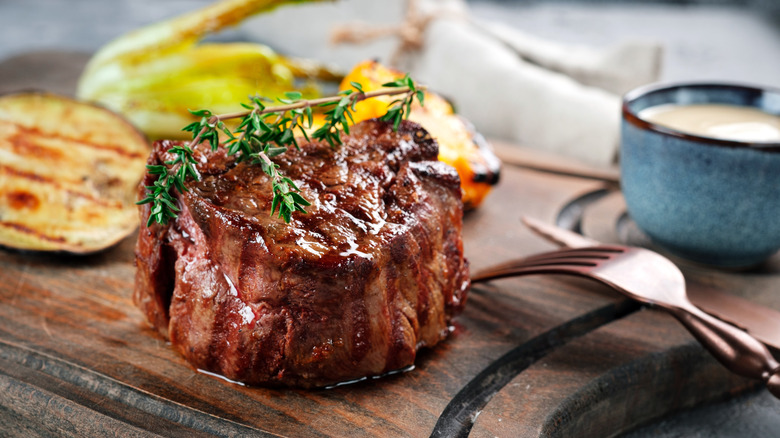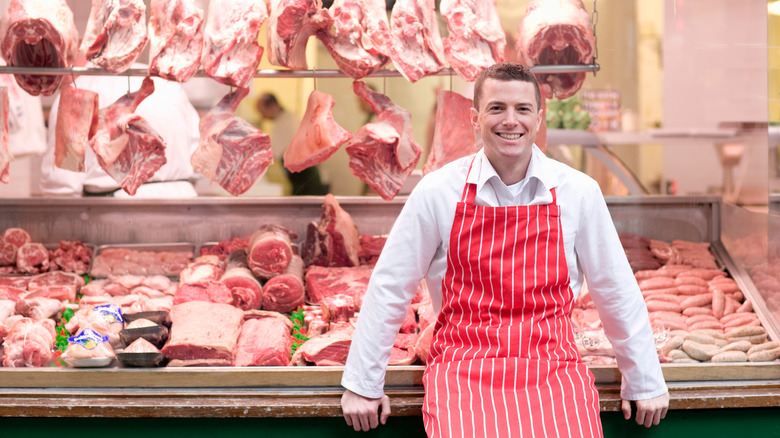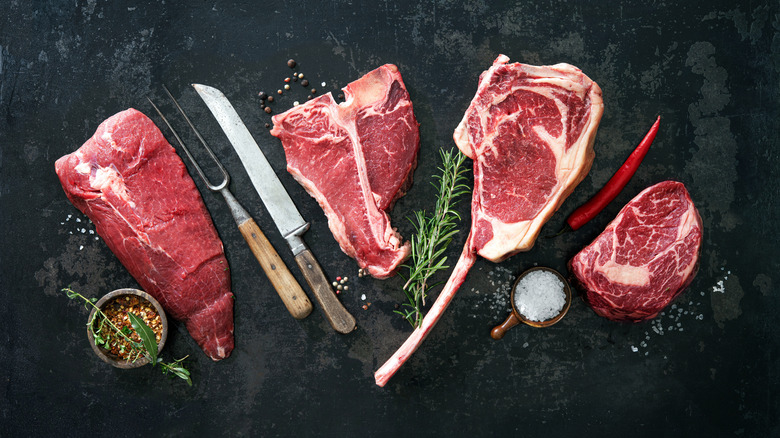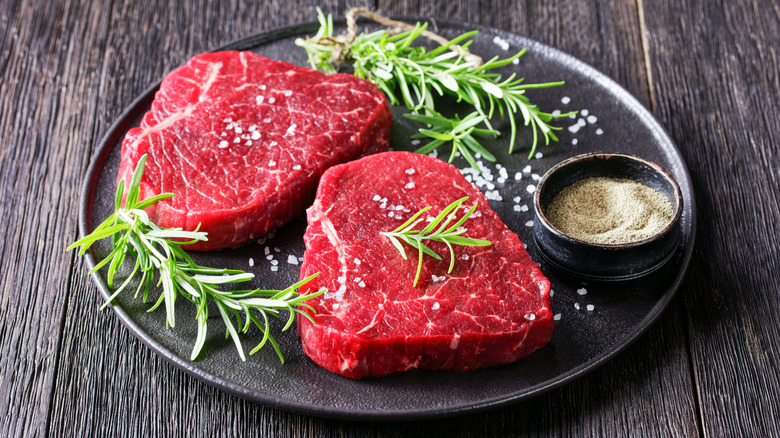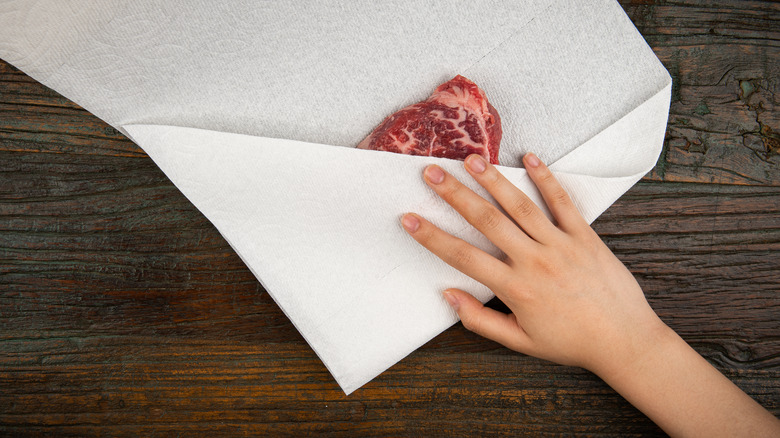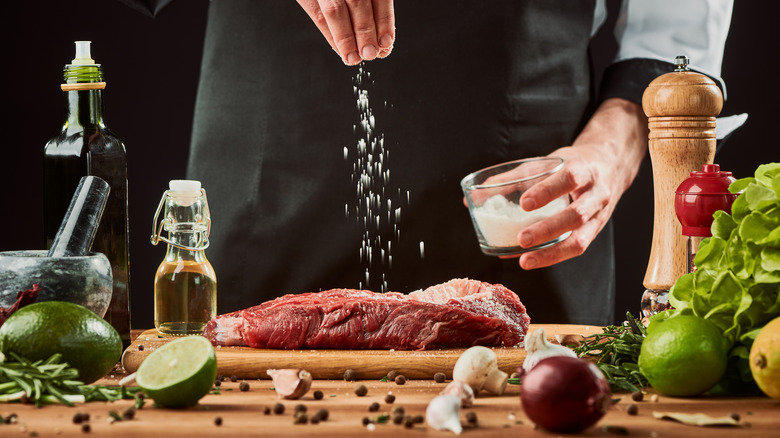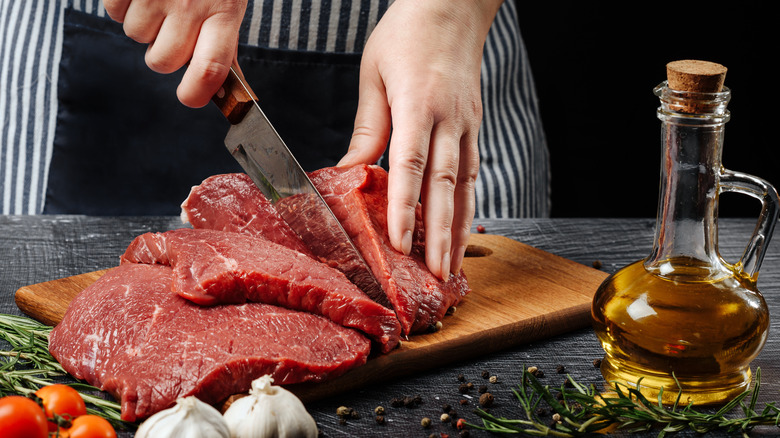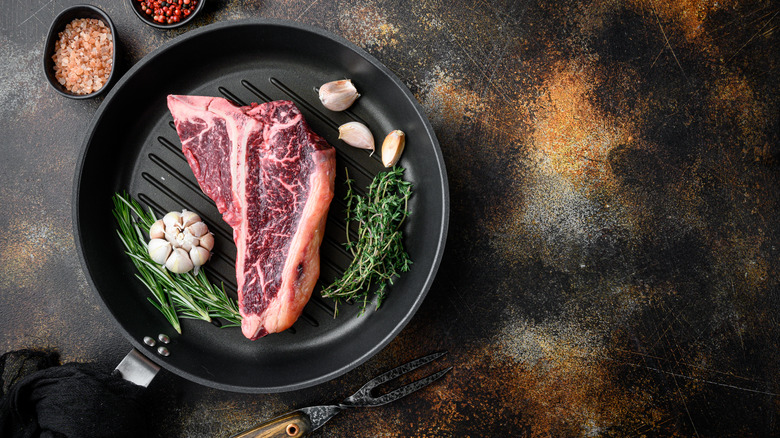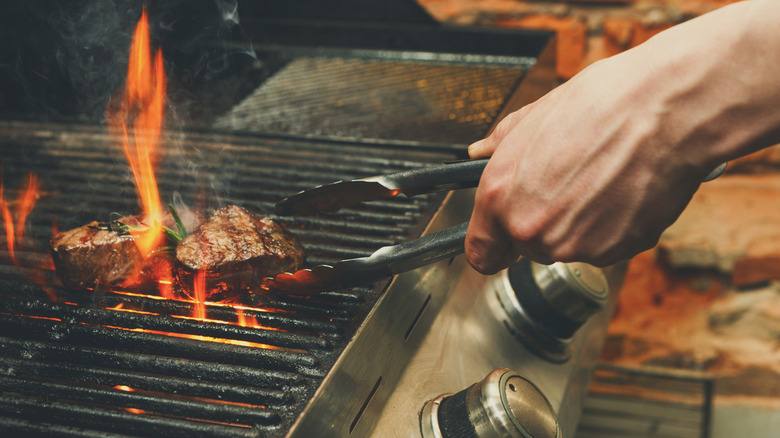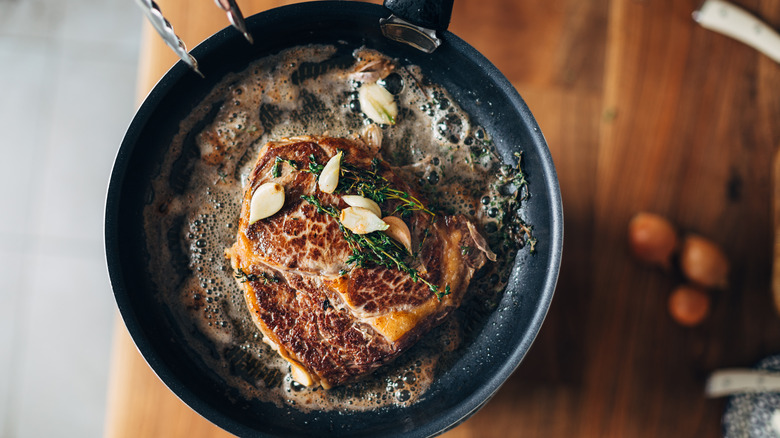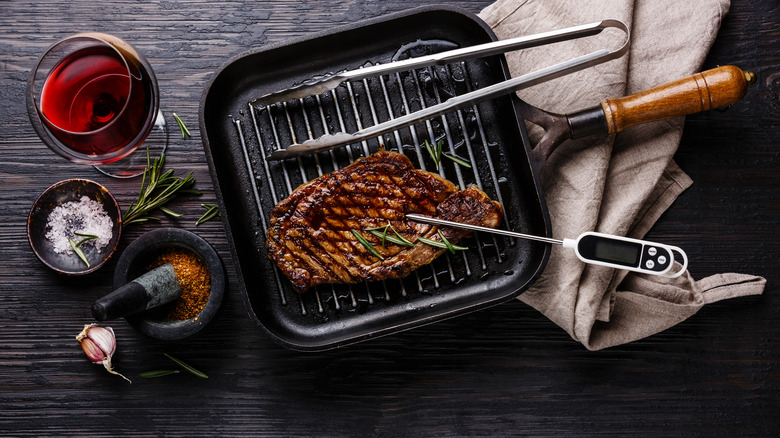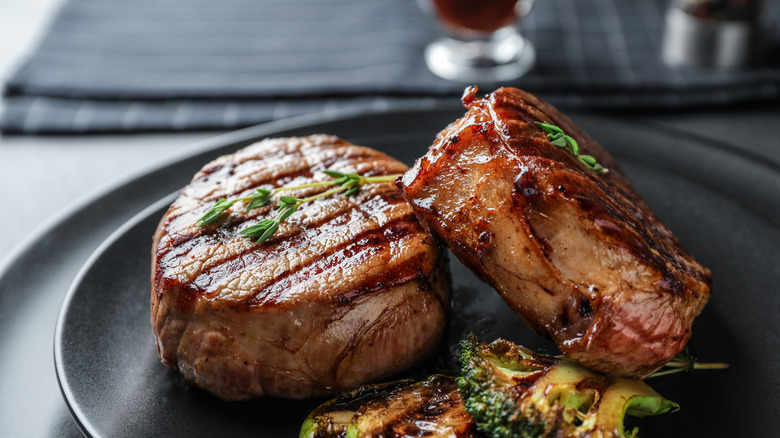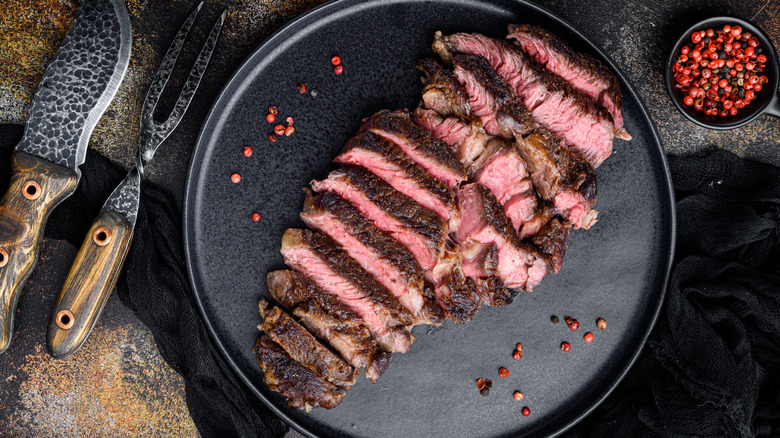12 Steakhouse Secrets You Can Use At Home
Restaurant fads come and go but it looks like steakhouses are here to stay. According to Statista, in 2018, around 37% of Americans between the ages of 18 and 64 visited a steakhouse in a period of three months. From the opening of Delmonico's in 1837 — a restaurant considered by many to be America's first steakhouse — the dish has risen from strength to strength among carnivores. After all, whether it's a juicy ribeye or a lean filet mignon, there's nothing quite like digging into a prime cut that's been cooked to your exact specifications.
Considering the popularity of steakhouse restaurants, it's little surprise that many of us have tried to replicate their meaty menu items in our own kitchens. However, beef can be a fickle beast. It's not only super easy to under or overcook, but it can also be ruined in dozens of other ways — or rather traps for the uninitiated. There's no need to despair, however, because with a few simple steakhouse secrets you too can make restaurant-quality steak at home.
1. Get friendly with your local butcher
All steakhouses worth their salt are able to rely on their beef suppliers and so should you. Even though you may not be buying meat in bulk, a good relationship with your local butcher can mean the difference between a prime cut and a dud. This is because your local butcher stocks the type of meat that simply isn't available at the grocery store, including ethically-raised, grass-fed, and hormone-free meat. They can also give you recommendations about different cuts, and tips about prep and cooking times (via The Kitchn). And once you establish a bond with your butcher, they are likely to remember your preferences and maybe even save you those special cuts they know you'll love.
Just like steakhouses, most butchers know the exact origins of their meat — you just need to ask (via Scotch Butchers). According to Michelin-Star Chef Hilary Henderson of CUT in Beverly Hills some of the best questions to ask your meat purveyor include, "What's good that day? What would they buy for themselves? When's the next shipment coming in?" (via Robb Report). The owner of a Minneapolis restaurant Vinai, Yia Vang, explains that he usually opts for locally-sourced meat, "Because our animals don't travel far, they have much less stress, and I believe you can taste that difference. Stressed animals release hormones that can make the meat tougher and mealy" (via HuffPost).
2. Know your cuts
Most steakhouses don't simply just serve steaks, but rather different cuts of beef — each with its own flavor profile and texture. And while knowing your porterhouse from a ribeye may not always come naturally, it's good to have at least a basic understanding of the cuts available at your local butcher shop. After all, the perfect steak is about much more than just the preparation method — you need the right ingredients to work with. So what are the more popular cut options at steakhouses? According to the Gentleman's Journal, sirloin, ribeye, and rump are the undisputed showstoppers, has they have great fat distribution and come from muscles that are more tender.
When it comes to steakhouses, how the steak is cut is just as important as the part of the cow it comes from. And in this department, thicker is usually better. This is because ensuring that a steak is perfectly seared on the outside and rarer in the center is generally much easier with a thicker cut. Chef David Walzog from SW Steakhouse in Wynn Las Vegas told Forbes, "There's a huge margin of error in cooking thin steaks, and if your meat guy has Prime, you're probably going to pay $30 a pound for it, so splurge — it's hard to screw up a thick steak."
3. Don't cook the meat straight out of the fridge
Once taken out of the fridge, it's important to let the steak come to room temperature before whacking it on the pan or grill. However, how long you let the meat sit out on the kitchen counter isn't an exact science. As highlighted by Bon Appétit, you don't need to wait until the meat is exactly 72 degrees Fahrenheit. And you certainly don't need to take its internal temperature with a meat thermometer prior to cooking. If you need a measuring stick, however, Celebrity Chef Donatella Arpaia told Insider that she leaves her steaks out of the fridge for around an hour.
Professionals agree that it's important to leave meat out of the fridge prior to cooking for a number of reasons. Firstly, placing a cold cut of meat on a grill or skillet will cause the muscle tissue to contract, making even heat distribution more tricky and increasing the likelihood of burning (via Great British Meat).
If meat cooks evenly, on the other hand, it's much easier to achieve the required level of doneness. Rob Levitt of Chicago's The Butcher & Larder summed up the dilemma of cooking meat straight out the fridge up when he told Bon Appétit, "The outside will be charred and the inside will be mostly gray meat with a little nugget of red in the middle."
4. Pat the meat dry before cooking
All steakhouse chefs know that it's crucial to pat steak dry with power towels right before placing it on a pan or grill. This is particularly important if the meat has seeped blood after cutting. Simply place your cuts on top of a stack of paper towels. Next, place another stack of paper towels on top of the cut. Press down gently and pat down the sides of the meat. End the process by dabbing any excess blood away (via Atco Blue Flame Kitchen).
So why is patting meat dry — even if it's been marinated — prior to preparation so important? According to Anton's Cafe Bar, drying the meat with a paper towel just before cooking ensures good contact between the steak and the pan. It also creates less steam during searing, which is definitely what you want since moisture prevents browning. To cut a long story short, if you don't pat the meat dry, the steak will still cook but won't get very crispy on the outside. In addition, moisture can create oil splatters, which aren't just messy but can also lead to some serious injuries (via Stack Exchange).
5. Know when and how to season your steak
While a good cut of beef can generally stand on its own, most steakhouses add some level of seasoning into the equation. Most steaks usually don't need much more than sea or kosher salt, ground black pepper, and perhaps a little bit of garlic. And salting is a crucial part of the seasoning process. Tender Greens Chef Pete Balistreri told Eat This, Not That, "Salt releases moisture in the muscle [of the meat] and releases the natural flavors of steak."
There's some disagreement among chefs as to when it's best to season your steak. According to Oola, it's best to season the meat right after you take it out of the fridge. This will ensure that the cut soaks in the seasoning, leaving you with a more flavorful dish. "Top Chef" finalist and owner of Cafe Firenze Chef Fabio Viviani disagrees, claiming that the steak should be seasoned right before cooking, "Applying salt too soon will dry out the meat and it won't be juicy and tender" (via Insider). Whatever you do, however, don't wait to season your steak until it's on your plate (via Gentleman's Journal).
6. Use the right cooking oil
When it comes to prime cuts, many chefs advise staying away from olive oil due to its low smoke point of between 300 and 350 degrees Fahrenheit — for the uninitiated, this is the temperature at which the oil starts to burn. When this point is reached, your culinary masterpiece could end up tasting scorched or rancid. In addition, the smoke can also leave carcinogenic compounds on the meat — something that you definitely want to avoid.
According to Home Cook World, the best oils for searing steak are avocado oil, soybean oil, and canola oil since all of them have high smoke points of between 400 and 520 degrees Fahrenheit. In addition, while you want to stay away from regular butter, which has a low smoke point of 300 degrees Fahrenheit, it's perfectly fine to cook steak with clarified butter since its smoke point stands at 450 degrees Fahrenheit. Alternatively, some chefs swear by searing the strip of fat on the side of the cut by holding the steak vertically with tongs before cooking it in the rendered fat (via BBC Good Food).
7. Use the right pan and make sure it's very hot
These days, many steakhouse chains, such as Ruth's Chris, use infrared broilers with their steaks to ensure extremely high temperatures and even heat distribution. Unfortunately, most of us don't have the luxury of such kitchen gear at home. There's no need to despair, however, since many chefs still swear by pan-frying their steaks. And many of them recommend using cast iron skillets. Chef Steve Doucakis told Michelin Guide that he uses cast iron pans because they hold heat, which ensures the right sear and caramelization. Since cast iron is a dense metal, it also ensures even heat distribution. This, in turn, translates to evenly cooked and browned steak (via Kitchn). Last but not least, for best results, veteran British Chef Kevin B. Thomson recommends that the skillet is "very hot, but not smoking."
Another method of steak preparation that's popular with some chefs is the reverse sear. The award-winning chef behind The Food Lab column at Serious Eats, J. Kenji López-Alt swears by this recipe. The cooking method involves slow-roasting the meat in the oven to the desired wellness and then searing the steak on a "screaming hot" cast iron skillet. "By starting steaks in a low-temperature oven, you wind up with almost no overcooked meat whatsoever ... [Then] when searing a piece of meat, our goal is to create a crisp, darkly browned crust to contrast with the tender, pink meat underneath," López-Alt proclaims.
8. Flip your steak rarely ... or as much as you like
Many of us have heard that turning the steak too much during pan searing or grilling can ruin a perfectly good cut of meat. The Executive Chef at Gordon Ramsay Steak at the Horseshoe Baltimore, Samantha Love, agrees. She told Thrillist that you should wait for the Maillard reaction to take place before flipping a steak, referring to the interaction of certain proteins and sugars at high temperatures that both browns the steak and makes it so damn delicious. At its most extreme, professionals advise that a steak should be flipped only once so as not to "agitate" the meat (via Home Cook World).
A more recent take on the steak preparation process amid chefs is that flipping the steak frequently doesn't downgrade its flavor or texture. According to the culinary guru, J. Kenji López-Alt flipping the steak as often as every 30 seconds actually improves the final result. He says that not only will turning the steak not prevent it from crusting, but it will also result in a more evenly cooked center — providing that you aren't cooking a thin and wet cut of meat on low heat, which is something you shouldn't be doing anyway. (via Serious Eats).
9. Baste the steak in butter and add aromatics
According to KitchnSeer, butter is the secret — and sometimes not so secret — weapon of many steakhouses. Even if there's no visible fat on your steak when it arrives at your table, chances are that it's been cooked in tablespoons of clarified butter. And there's a good reason for this. Butter is said to not only increase beef's flavor and texture but also give it an appealing glossy finish.
Most chefs recommend adding butter well into the searing process. This is because butter has a low smoke point, which means that it starts to burn at around 300 degrees Fahrenheit. This, in turn, can make the steak bitter — not to mention smoke out your neighbors (via Home Cook World). The Michelin star meat master Alain Ducasse recommends adding butter to the skillet after the steak is already browned, and using the melted butter and garlic to baste it (via Gentleman's Journal). So does celebrity chef Gordon Ramsey who believes in basting his steaks in butter infused with crushed garlic and thyme for additional flavor.
10. Get the timing right
One great thing about steakhouses is that they can cook a steak to your exact specifications. Whether it's rare or well done, getting your steak just right can be the trickiest part of preparing the dish in your own kitchen. This is because how long it takes to cook the perfect steak depends on many factors including the thickness of the cut and the temperature of the grill. Sure, you can cut into the steak to check whether it's ready but this isn't recommended since it lets out the juices (via Kitchn). To help, culinary gurus from Hestan Cue have come up with a chart that outlines the exact searing times and temperatures for different cuts of meat and wellness levels.
Since many of us aren't great at following tables, there is another method that can prevent your cut from coming out over or underdone — a meat thermometer. Available in either digital or analog versions, meat thermometers are inserted into the center of the meat to gauge its internal temperature. In the case of a medium-rare steak, this should be around 130 degrees Fahrenheit. However, because the steak will continue to cook on the plate, it should be removed from the source of heat when it's 5 degrees Fahrenheit lower than the desired temperature.
11. Let the steak rest prior to serving
When you prepare a steak on a scorching hot skillet or grill, you're forming a crust that locks in moisture. If you cut into your steak right after it's removed from heat, you risk losing all these wonderful juices. Chef J. Kenji López-Alt explains that this happens because the meat's juices are forced to the center during the cooking process, "The center of the steak becomes supersaturated with liquid — there's more liquid in there than it can hold on to — so when you slice it open, all that extra liquid pours out. By resting the steaks, you allow all that liquid that was forced out of the edges and into the center time to migrate back out to the edges" (via Serious Eats).
The executive chef at Gordon Ramsay Steak at the Horseshoe Baltimore Samantha Love told Thrillist that the time you let the cut rest should depend on its size — the bigger the steak, the longer it takes for the juices to redistribute themselves. She recommends that thin steaks should rest between five and seven minutes, while thicker cuts of meat should sit out on the plate for at least 10 minutes. According to López-Alt, you can even use a meat thermometer to check if your steak is sufficiently rested. No matter how thin or thick the steak, ideally you want its center to cool down to 120 degrees Fahrenheit.
12. Cut the steak against the grain and serve on a warm plate
Steakhouse specialists realize that how you present a steak can have a huge impact not just on its visual appeal but also on its flavor and texture. If you want to cut the meat prior to serving, always cut against the grain or perpendicular to the direction of the muscle fibers. Since muscle fibers can be on the tough side, slicing through them will make the beef more tender. Slicing along the muscle fibers, on the other hand, will have the opposite effect, making the steak chewier.
Another trick to elevating your home dining experience to a restaurant level is by warming the plate prior to serving. This is because a warm plate helps to maintain an even temperature of the food while a cold one absorbs its heat, which could translate to a lukewarm steak (via Chef's Vision). One of the best ways to warm your plates is by stacking them in the oven set at a low temperature or by placing them on the stovetop burner once it's been turned off (via LifeHacker).
